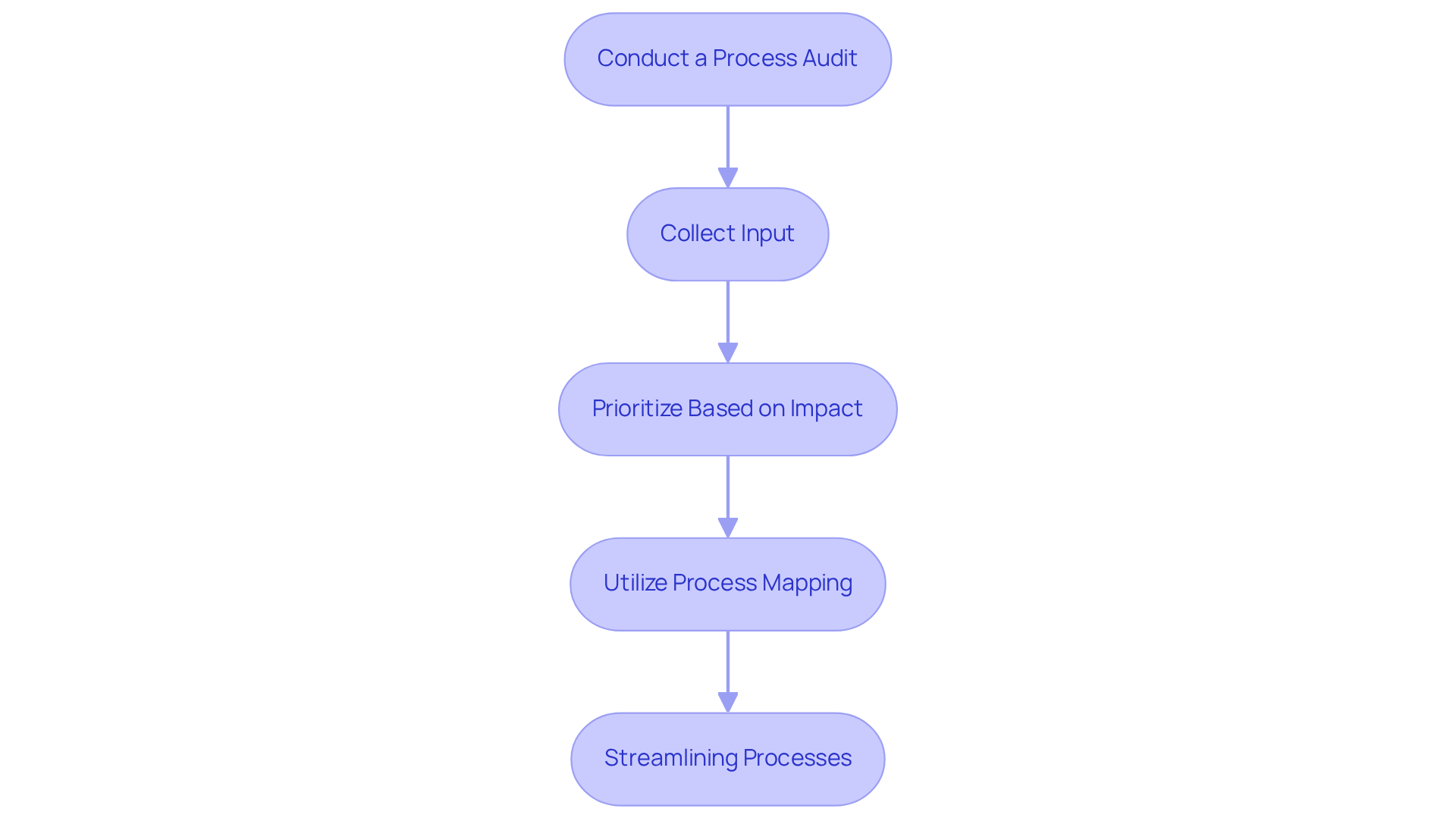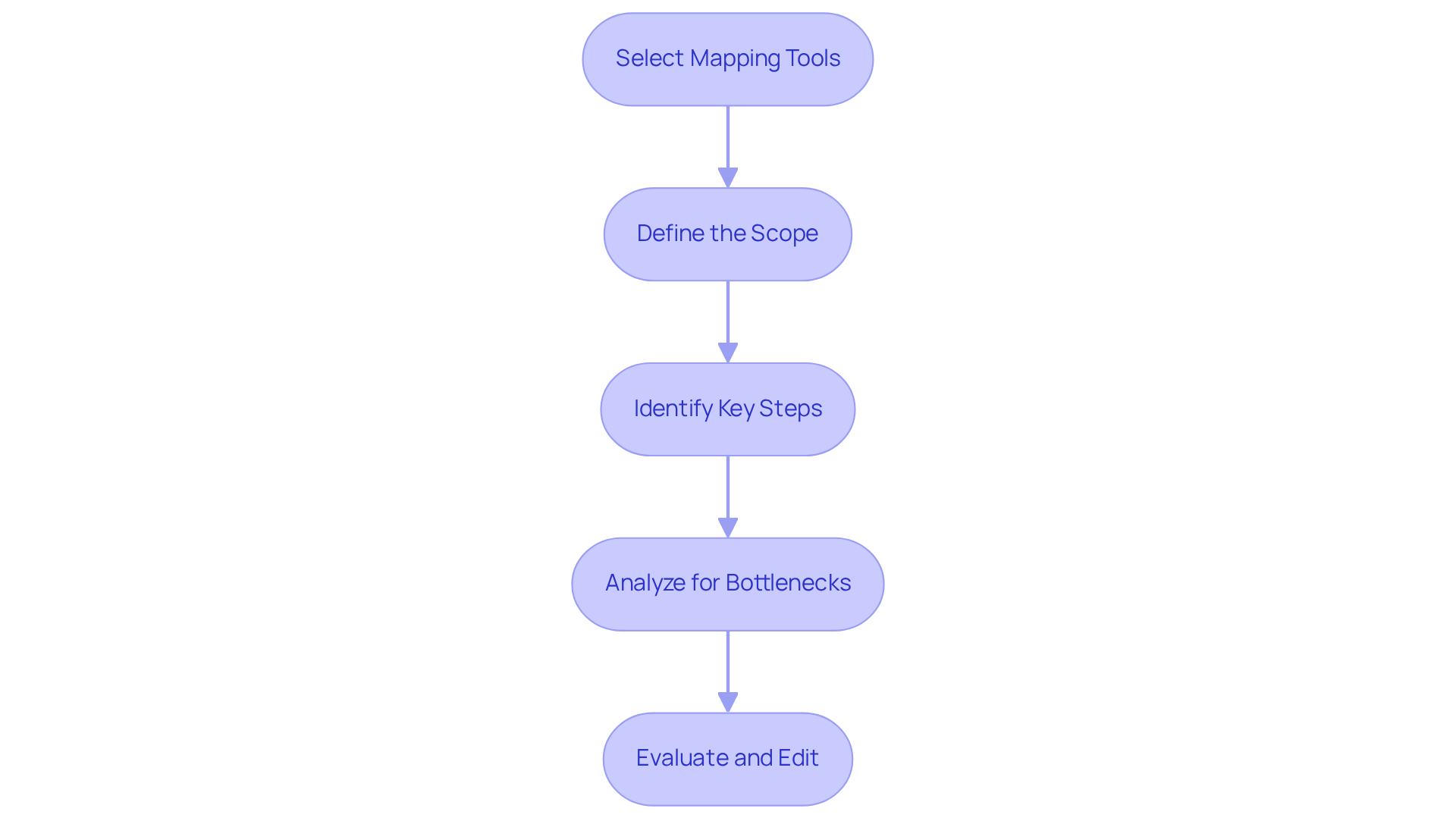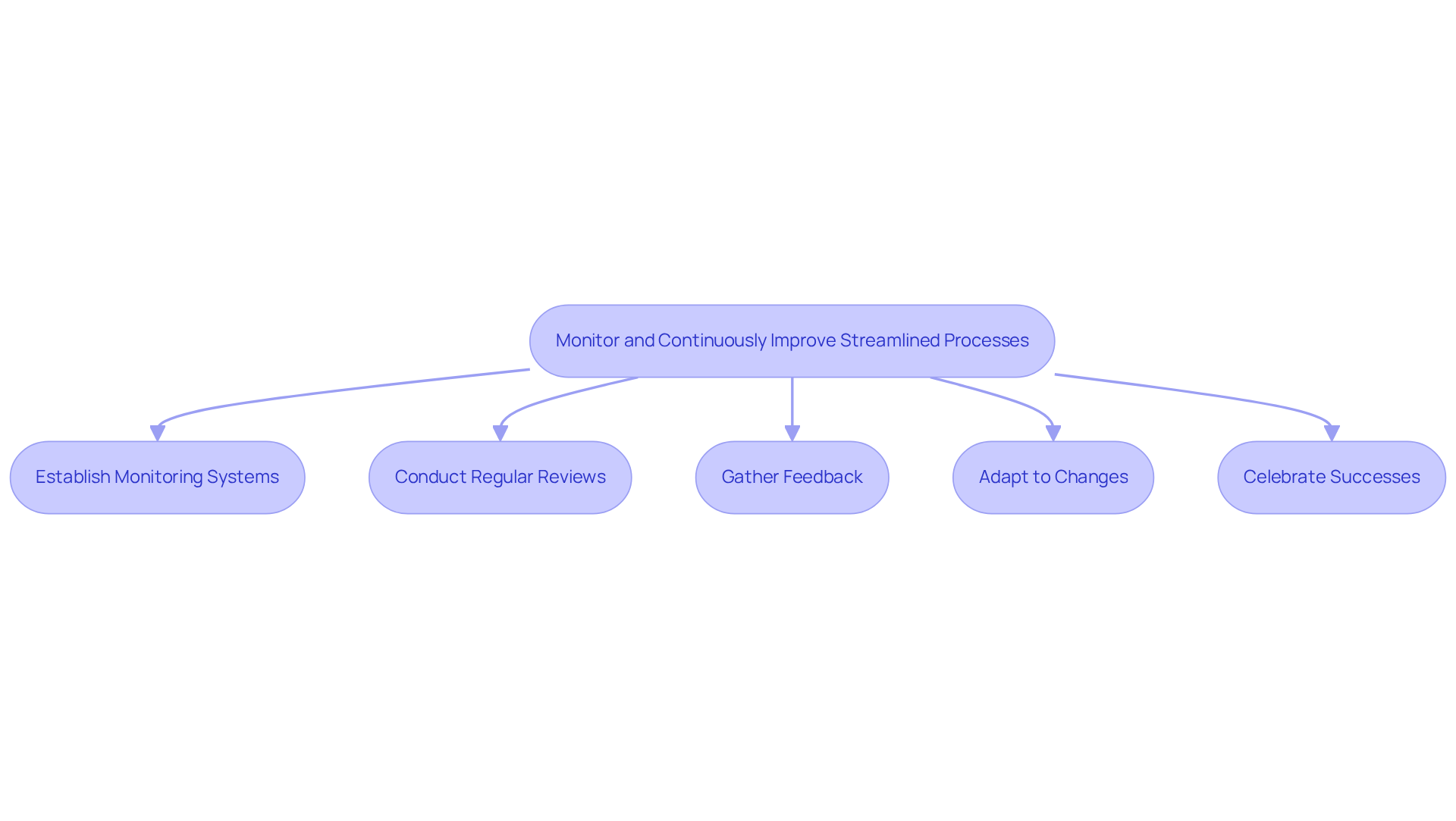
Process Improvement through Documentation
|
October 28, 2025
|
5 Steps to Streamline a Business Process Effectively
Overview
You might be wondering how to streamline your business processes effectively. Well, the article lays out five essential steps that can help you do just that!
- Identify those pesky inefficient workflows.
- Map out your current processes.
- Implement some smart optimization strategies.
- Commit to continuous improvement.
These steps work together to enhance operational efficiency, cut down on costs, and boost customer satisfaction. By eliminating unnecessary steps, automating tasks, and fostering a culture of ongoing feedback and adaptation, you’ll be on your way to a smoother operation. So, are you ready to dive in and explore how these strategies can transform your business?
Key Highlights:
- Streamlining business processes boosts operational efficiency and reduces costs by eliminating unnecessary steps and automating repetitive tasks.
- Key benefits of streamlining include time savings, cost reduction, enhanced quality, and improved customer satisfaction.
- Identifying inefficient workflows can be achieved through process audits, employee input, prioritisation based on impact, and process mapping.
- Effective process mapping clarifies roles and responsibilities, helps identify bottlenecks, and supports continuous improvement.
- Strategies for optimising workflows include eliminating unnecessary steps, automating tasks, standardising procedures, enhancing communication, and setting clear goals.
- Monitoring and continuous improvement are essential for maintaining streamlined processes, involving regular reviews, gathering feedback, and adapting to changes.
Introduction
Streamlining business processes has become a crucial strategy for organizations looking to boost efficiency and cut down on operational costs. You might be wondering how this works—well, by trimming unnecessary steps and automating those repetitive tasks, companies can save precious time and create a more engaged workforce that focuses on high-impact activities. But here’s the catch: the journey to optimization isn’t always smooth sailing.
How can businesses pinpoint which processes to streamline and make sure those improvements stick? Let’s dive into some practical steps to transform workflows and uncover key strategies that can lead to big wins in productivity and customer satisfaction.
Understand the Importance of Streamlining Business Processes
Optimizing business workflows is crucial for learning how to streamline a business process, which in turn boosts operational efficiency and reduces costs. You might be wondering how that works, right? Well, by getting rid of unnecessary steps and automating those repetitive tasks, organizations can save a ton of time and resources. This not only ramps up productivity but also makes employees happier, letting them focus on work that really matters. Plus, when systems run smoothly, customers enjoy better experiences since services are delivered faster and with higher quality. Recognizing these benefits is crucial for companies looking to prioritize optimizing their operations.
Now, let’s talk about how this system can transform documentation processes. One product owner shared, "This platform has been a game changer in the way we document work and deliver to our clients." Imagine not having to take each screenshot separately or even leaving your browser while creating SOPs and training materials. This service has given me back some precious time! This really shows how SowFlow's instant SOP creation and time-saving features can dramatically improve documentation efficiency and user experience.
Key Benefits of Streamlining:
- Time Savings: Cutting down task duration allows teams to use resources more effectively, boosting overall productivity.
- Cost Reduction: Streamlined methods often lead to lower operational expenses by reducing waste and redundancy, which means significant savings.
- Enhanced Quality: Fewer steps in a process mean fewer chances for mistakes, resulting in better outputs and more consistency.
- Enhanced Customer Satisfaction: Quicker and more reliable services lead to happier clients, which fosters loyalty and repeat business.
By recognizing these advantages, businesses can motivate their teams to embrace the necessary changes for effective streamlining and understand how to streamline a business process, ultimately driving growth and innovation. So, are you ready to dive into streamlining your operations?

Identify Processes That Need Streamlining
To effectively simplify business operations, you might be wondering how to streamline a business process. The first step is to identify workflows that are inefficient or cumbersome. Here are some strategies to help you pinpoint these processes:
-
Conduct a Process Audit: Have you ever felt stuck in a bottleneck? Reviewing existing workflows can help identify those pesky delays and redundancies. You can do this by chatting with your team and analyzing performance metrics, which are key to understanding how efficiently things are running.
-
Collect Input: It’s crucial to involve employees who are directly engaged in the activities. Their insights can uncover pain points that might not be obvious at first glance, but they can significantly impact your improvement initiatives. Research shows that organizations that actively seek employee feedback can really boost their optimization strategies.
-
Prioritize Based on Impact: Now, let’s talk about prioritization. Focus on methods that truly influence productivity or customer satisfaction. Use criteria like how often a process is used, how much time it takes, and error rates to rank procedures. This way, you tackle the most critical workflows first, leading to substantial improvements in operational efficiency.
-
Utilize Process Mapping: Have you tried creating visual representations of workflows? Process mapping can help you better understand the flow of tasks and spot areas that need improvement. It not only clarifies the current state but also helps you visualize potential enhancements.
By systematically recognizing procedures that need streamlining, your organization can learn how to streamline a business process to ensure that optimization efforts yield the greatest benefits. In the end, this leads to improved efficiency and happier customers!

Map Current Processes for Clarity and Efficiency
Once you’ve spotted the procedures that could use a little streamlining, you should consider how to streamline a business process. It’s time to outline them! Creating a visual representation of each workflow can really help clarify roles, responsibilities, and task sequences, ultimately boosting efficiency. Here’s how you can effectively map out your current processes:
- Select Mapping Tools: So, what tools should you use? Think flowcharts, swimlane diagrams, or even specialized software like Lucidchart and Miro to create your workflow maps. These tools make it super easy for everyone on your team to communicate and understand the processes. Plus, incorporating SowFlow lets you whip up user guides that provide instant access to documentation, ensuring everyone is on the same page.
- Define the Scope: Next up, let’s get clear on the start and end points of the procedure you’re mapping. This focus contributes to understanding how to streamline a business process by preventing unnecessary details from creeping in.
- Identify Key Steps: Now, break the procedure down into individual steps and note who’s responsible for each task. This is a great way to uncover any redundancies and inefficiencies. Remember, continuous improvement is key to operational success! With this approach, you can easily update your documentation to keep it relevant as things change.
- Analyze for Bottlenecks: Take a close look at where delays happen or tasks tend to pile up. These bottlenecks usually need the most attention when learning how to streamline a business process, as addressing them can significantly boost productivity. And guess what? Using this platform allows you to access your documentation knowledge with just a command, so you can skip those unnecessary meetings!
- Evaluate and Edit: Lastly, share those workflow diagrams with your team for feedback. This collaborative approach not only ensures accuracy but also nurtures a culture of continuous improvement. Insights from different stakeholders can lead to better outcomes. With SowFlow, updating guides is a breeze, allowing for real-time adjustments that really amp up team productivity.
Mapping out your methods does more than just highlight inefficiencies—it serves as a reference point for making impactful changes. As organizations pursue operational excellence, the ability to visualize workflows becomes a distinct competitive advantage. For example, using swimlane diagrams can clarify roles and enhance coordination in cross-functional workflows, ultimately leading to improved productivity.

Implement Strategies to Optimize Workflows
With a clear understanding of existing procedures and the inefficiencies that come with them, you might be wondering how to enhance your workflows. Well, it’s time to dive into some effective strategies that can make a real difference:
- Eliminate Unnecessary Steps: Take a good look at your procedures and see if there are any steps that just don’t add value. Organizations that understand how to streamline a business process can significantly boost efficiency and save up to 240 hours a year per employee by simplifying their processes. Who wouldn’t want that?
- Automate Repetitive Tasks: Think about the tasks you do over and over again. Can they be automated? Tools like Flow can help with that! Automation not only cuts down on manual work but also reduces errors. In fact, studies show that automation can lead to a 50% reduction in costs and a 14.5% increase in productivity for sales teams.
- Standardize Procedures: Have you considered creating standard operating procedures (SOPs) for your tasks? This ensures everyone is on the same page, maintaining quality and consistency across the board. Plus, with the user guide features of this platform, documenting these procedures becomes a breeze, making training new staff easier and potentially boosting operational efficiency by up to 30%.
- Enhance Communication: Let’s talk about communication. Implementing tools that improve how your team communicates can work wonders. With this platform, you can access documentation instantly, which cuts down on misunderstandings and boosts collaboration—resulting in a 42% increase in task completion speed!
- Set Clear Goals and KPIs: It’s essential to set specific objectives for your streamlining efforts. What do you want to achieve? Using key performance indicators (KPIs) can help you measure success and tweak your approach as needed. Organizations that set clear goals often see a positive impact on employee satisfaction and productivity.
By applying these strategies and tapping into SowFlow's innovative documentation solutions—like dedicated customer success agents and training in best practices—you can discover how to streamline a business process that not only enhances productivity but also cuts down on operational costs. This leads to a more scalable and structured business environment. So, are you ready to take the plunge?

Monitor and Continuously Improve Streamlined Processes
To ensure the effectiveness of your streamlining strategies, you might be wondering how to streamline a business process and maintain the momentum. Organizations really need to prioritize continuous improvement as an ongoing commitment. Here are some essential steps to maintain and enhance those streamlined processes:
-
Establish Monitoring Systems: Have you thought about implementing dashboards and analytics tools? They can help you track key performance metrics in real-time. According to SAP Signavio's recent release on March 3, 2025, using AI-assisted tools can significantly cut down the time and costs linked to enterprise modeling. This makes it easier to spot issues quickly and jump on them before they escalate.
-
Conduct Regular Reviews: Scheduling periodic evaluations of your procedures can really make a difference. Team meetings are a great way to discuss what’s working and what needs a little TLC. A case study on the performance analysis of smart services in Chicago shows how regular reviews can boost service delivery and operational efficiency.
-
Gather Feedback: Don’t forget to ask for insights from your team members who interact with the procedures daily. Their firsthand experiences can reveal valuable nuggets of information for further enhancements. As Lucas de Boer, global marketing program head for SAP Signavio, points out, involving everyday business users in workflow analysis can lead to much better outcomes.
-
Adapt to Changes: Staying agile is key! Be ready to tweak your procedures as business needs evolve. Flexibility is crucial for keeping things efficient in a fast-paced environment, ensuring that your operations stay aligned with your organizational goals. The recent trends in integrating generative AI in process modeling really support this adaptability.
-
Celebrate Successes: And hey, don’t forget to acknowledge and celebrate the wins within your team. Recognizing achievements helps foster a positive culture around continuous improvement, keeping your team engaged and motivated.
By committing to these practices, you can ensure that you understand how to streamline a business process that not only delivers sustained benefits but also adapts effectively to future challenges. Continuous improvement isn’t just a strategy; it’s a vital component of operational excellence that drives long-term success.

Conclusion
Streamlining business processes isn’t just a passing fad; it’s a key strategy for boosting operational efficiency and driving growth. Have you ever thought about how eliminating unnecessary steps and automating those repetitive tasks could really ramp up productivity? By doing so, organizations can not only cut costs but also enhance customer satisfaction. The insights shared in this article truly highlight how optimizing workflows can lead to happier employees and a better experience for clients.
So, what are some key strategies for effective streamlining? Well, it starts with:
- Conducting thorough audits to pinpoint inefficiencies.
- Mapping out current processes for clarity.
- Implementing automation and standardization.
Each of these steps helps create a more organized and efficient operation. Plus, establishing monitoring systems and nurturing a culture of continuous improvement ensures that businesses stay agile and ready to adapt to changing needs.
Now, let’s talk about why embracing these streamlining principles is essential for any organization looking to thrive in today’s competitive landscape. By committing to these practices, businesses not only enhance their immediate operations but also set the stage for long-term success and innovation. Taking action to optimize workflows isn’t just a necessity; it’s a strategic move that can really propel organizations toward their goals.
Frequently Asked Questions
Why is streamlining business processes important?
Streamlining business processes is crucial because it boosts operational efficiency, reduces costs, saves time and resources, increases productivity, and enhances employee satisfaction. It also leads to better customer experiences through faster and higher-quality service delivery.
What are the key benefits of streamlining business processes?
The key benefits include time savings, cost reduction, enhanced quality, and improved customer satisfaction. Streamlining reduces task duration, lowers operational expenses, minimizes mistakes, and fosters client loyalty.
How can organizations identify processes that need streamlining?
Organizations can identify processes needing streamlining by conducting a process audit, collecting input from employees, prioritizing based on impact, and utilizing process mapping to visualize workflows.
What is a process audit and how can it help?
A process audit involves reviewing existing workflows to identify delays and redundancies. It helps organizations understand efficiency levels and pinpoint bottlenecks that need addressing.
Why is employee input important in streamlining processes?
Employee input is crucial because those directly engaged in activities can provide insights into pain points that may not be immediately obvious, significantly impacting improvement initiatives.
How should organizations prioritize processes for streamlining?
Organizations should prioritize processes based on criteria such as frequency of use, time taken, and error rates, focusing on methods that influence productivity or customer satisfaction the most.
What is process mapping and how does it help in streamlining?
Process mapping involves creating visual representations of workflows, which helps organizations understand the flow of tasks and identify areas for improvement, clarifying the current state and potential enhancements.
👍
What others are liking
5 Steps to outline your ideal documentation structure
5 MINS READ
Where to start the your journey of mapping out your ideal documentation structure, aligning it with the very heartbeat of your organization?
Defining a winning level of detail in your process
3 MINS READ
What is too much detail, and what is too little? This article described in that winning level detail about what detail is enough.





